Understanding the True Cost of Backup Power
Whole house generator installed price typically ranges from $6,000 to $11,000 for a complete installation, including both equipment and labor.
| Cost Component | Price Range |
|---|---|
| Generator Unit | $3,000-$6,000 |
| Installation Labor | $3,000-$5,000 |
| Total Installed | $6,000-$11,000 |
| Per Kilowatt Cost | $800-$1,000/kW |
| Daily Operating Cost | $30-$170 |
When severe weather strikes or the power grid fails, a whole house generator becomes more than a convenience—it’s your family’s lifeline to normalcy. As power outages become more frequent across the country, homeowners are increasingly investing in permanent backup power solutions. But understanding the true cost involves more than just the price of the generator itself.
The investment in a whole house generator is significant, but so are the returns: uninterrupted heating and cooling, protection for sensitive electronics, continued operation of medical devices, and prevention of food spoilage. For many homeowners, the peace of mind alone justifies the expense.
I’m Jesse Burnett, a Master Electrician with experience in whole house generator installed price analysis and installation, having completed hundreds of Generac and other standby generator systems throughout the CSRA region. My team at Dr. Electric CSRA specializes in designing cost-effective backup power solutions that balance upfront investment with long-term reliability.
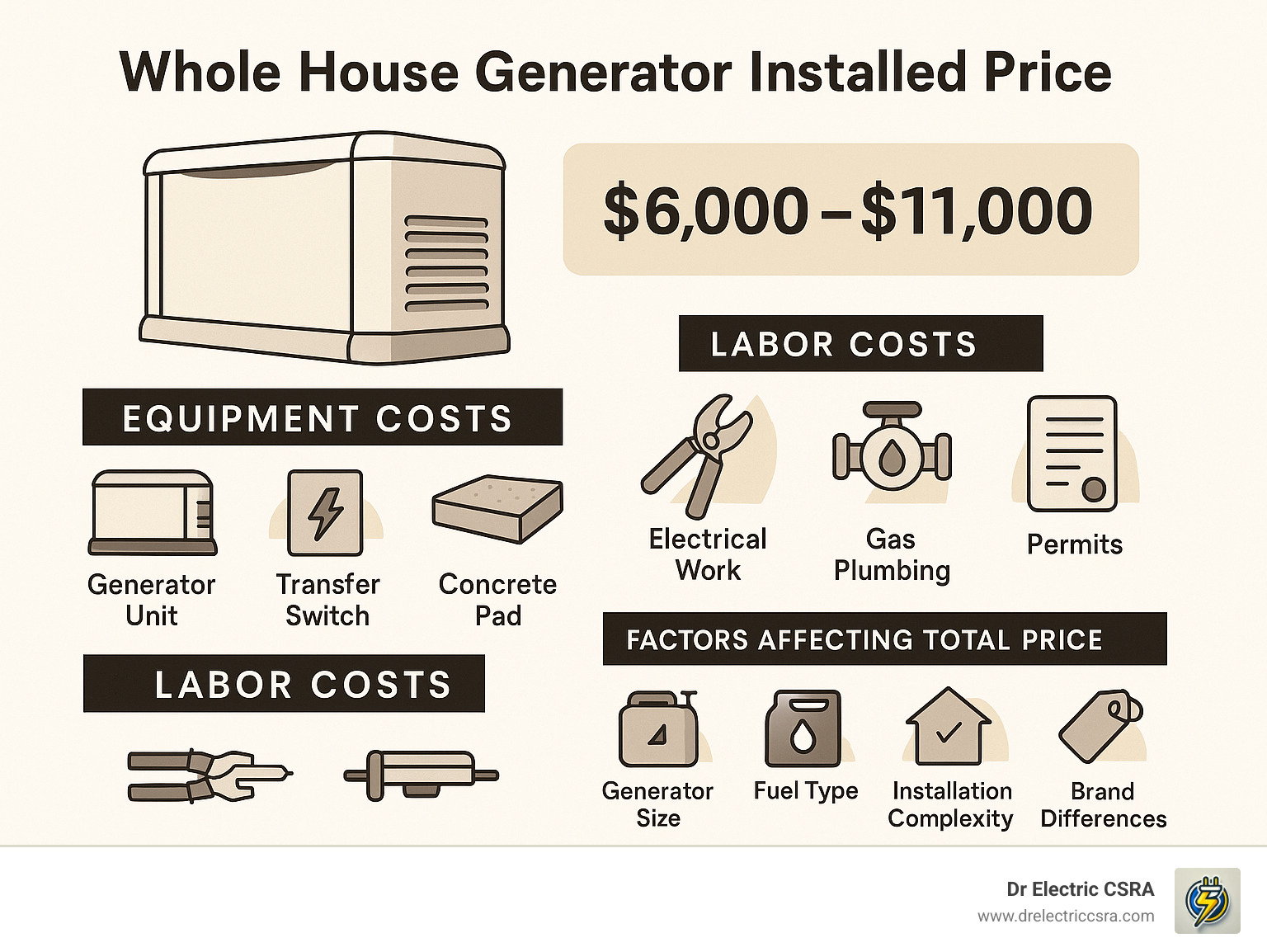
Whole house generator installed price terms to know:
– Whole House Transfer Switch Installation Made Simple
– installing transfer switch for whole house generator
What Is a Whole House Generator and How It Works
When the lights go out and the neighborhood goes dark, a whole house generator stands ready as your silent guardian. Also called a standby generator, this permanent fixture sits outside your home like a faithful watchdog, waiting for the moment your power fails. Unlike those noisy portable units you have to drag out of the garage, a whole house generator is professionally installed, hardwired directly into your home’s electrical system, and typically runs on natural gas or propane for a seamless transition when you need it most.
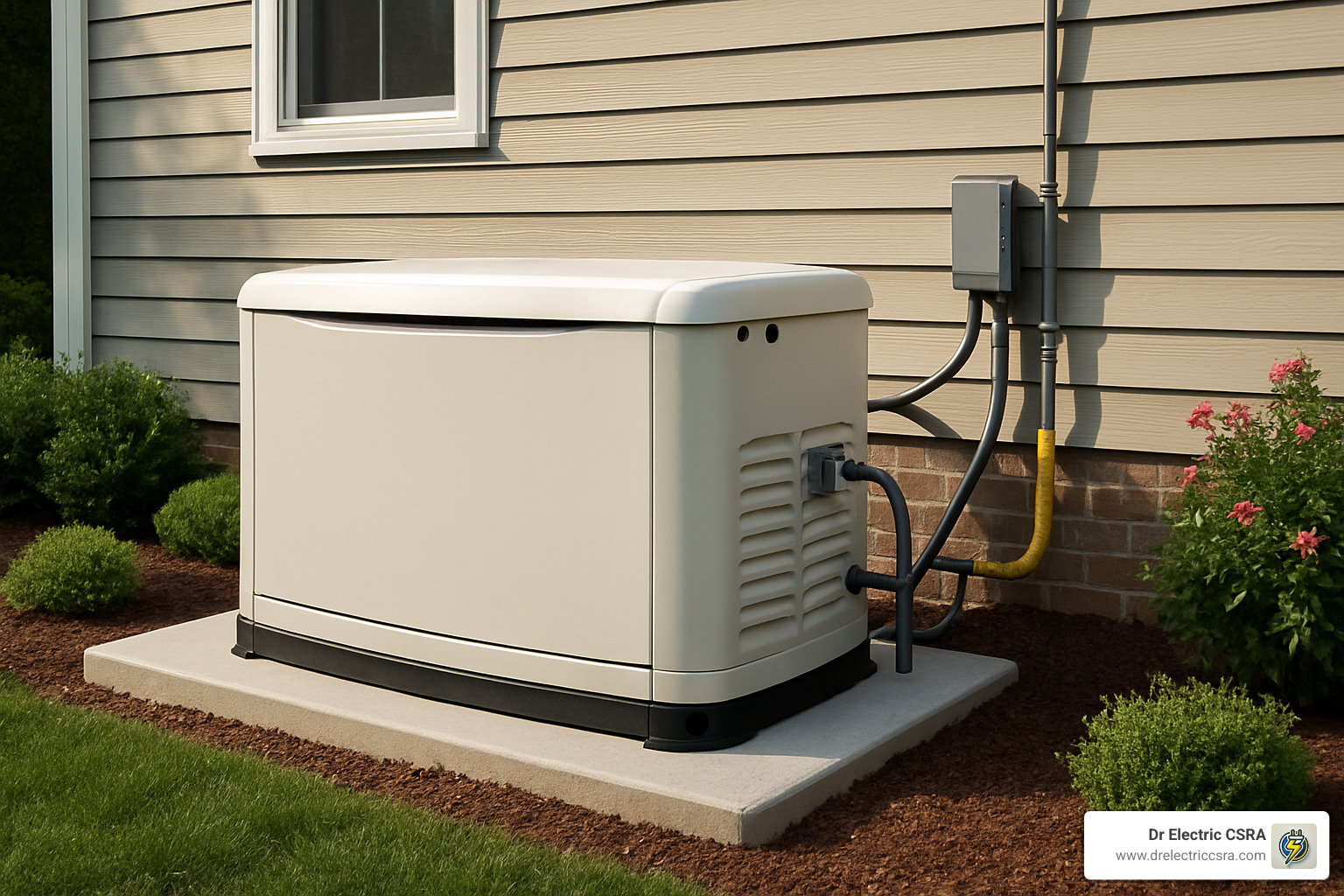
Components and Operation Cycle
Think of your generator system as having a brain and muscles working together. The controller serves as the brain, constantly monitoring your utility power and running weekly self-tests to ensure everything’s ready when needed. The moment an outage occurs, the automatic transfer switch (ATS) springs into action, detecting the power loss in seconds and switching your home’s circuits from utility to generator power.
No more fumbling with flashlights or rushing outside in a storm – the engine and alternator combo kicks in automatically, producing the electricity your home needs. The system’s load-sensing technology intelligently manages your power demands, ensuring you don’t overload the circuit. All of this happens within seconds, so quickly you might only notice a brief flicker before your lights, refrigerator, and Wi-Fi are humming along again.
Your generator’s fuel supply – whether natural gas, propane, or in some cases diesel – provides continuous power for days or even weeks without intervention. The seamless transition happens whether you’re home or away, giving you peace of mind no matter where life takes you.
Benefits Over Portable Options
The difference between a portable generator and a whole house standby system is like comparing a camping lantern to your home’s lighting system. With hands-free startup, you’ll never again be that neighbor wrestling with extension cords in the rain or refilling gas tanks in the dark. Your standby system eliminates the dangerous carbon monoxide risks associated with portable units running too close to your home.
Full home coverage means everything from your sump pump to medical devices keeps running without interruption. Many homeowners don’t realize that a properly sized system can power their entire home, not just a few “essential” circuits.
When it comes to your home’s value, the whole house generator installed price often pays for itself. National averages show these systems can increase property values by up to 5% and deliver an impressive 150% return on investment when you sell. In today’s uncertain climate of increasing power outages, homes with backup power have a distinct market advantage.
The safety and reliability factors alone justify the investment for many families. Standby systems are fully code-compliant, preventing dangerous back-feeding to utility lines that can harm repair workers. Plus, your system tests itself weekly, ensuring it’s always ready when you need it most – unlike that portable unit that might not start after sitting unused for years.
For more details on proper installation, check out our guide on Whole House Transfer Switch Installation Made Simple or learn about installing transfer switch for whole house generator.
Whole House Generator Installed Price: National Averages and Real Numbers
Let’s talk dollars and cents—what really matters when you’re planning your home backup power system. The whole house generator installed price typically lands between $6,000 and $11,000 for a complete installation in an average home (up to 3,000 square feet).
When I sit down with homeowners in Augusta, many are surprised to learn the generator unit itself is only about half the total investment. The rest goes toward installation, permits, electrical work, and all the components that make your system safe and reliable.
Here’s how those numbers typically break down:
| Cost Component | Price Range |
|---|---|
| Generator Unit | $3,000 – $6,000 |
| Installation Labor | $3,000 – $5,000 |
| Transfer Switch | $400 – $2,500 |
| Concrete Pad | $150 – $1,000 |
| Permits & Inspections | $200 – $800 |
| Total Installed | $6,000 – $11,000 |
| Per Kilowatt (kW) Cost | $800 – $1,000/kW |
Breaking Down Equipment Costs
Your equipment costs start with the generator itself—typically $3,000 to $6,000 for most homes needing 13-22 kW units. Then there’s the transfer switch ($400-$2,500), which is the brains of your backup system. The price varies based on amperage and whether you choose smart features that can manage which appliances get priority power.
Don’t forget the concrete pad ($150-$1,000) that keeps your generator stable and compliant with local codes. Many of my customers also opt for useful accessories like cold weather kits ($200-$400) for our occasional Georgia freezes, wireless monitors ($200-$400) so you can check your generator’s status from your phone, and smart load managers ($150-$300) that prevent overloading.
For a complete 22kW system with all the essentials, expect equipment costs around $6,500-$7,500 before we factor in labor.
Breaking Down Labor & Permit Costs
Installation is where experience really matters. Our team handles everything from electrical wiring (connecting to your main panel and installing the transfer switch) to gas plumbing (safely routing natural gas or propane lines to your generator).
Sometimes we need to do trenching work if your generator isn’t located near your meter, which adds to labor costs. Permits and inspections typically run $200-$800, depending on local requirements in Augusta and surrounding areas.
All told, professional installation typically costs $3,000-$5,000, covering all labor and coordination with gas companies, inspectors, and other professionals needed to complete your project safely.
If you’d like to see a detailed breakdown of all the services included in our generator installations, check out our Electrical Services page where we explain everything we handle from initial consultation to final testing.
For more information about transfer switches specifically, take a look at our guide to Whole House Transfer Switch Installation Made Simple or learn about installing transfer switch for whole house generator.
7 Factors That Influence Your Whole House Generator Installed Price
When it comes to backup power, there’s no one-size-fits-all price tag. Your specific situation will shape what you’ll pay for peace of mind during outages. Let’s look at what really drives your final investment:
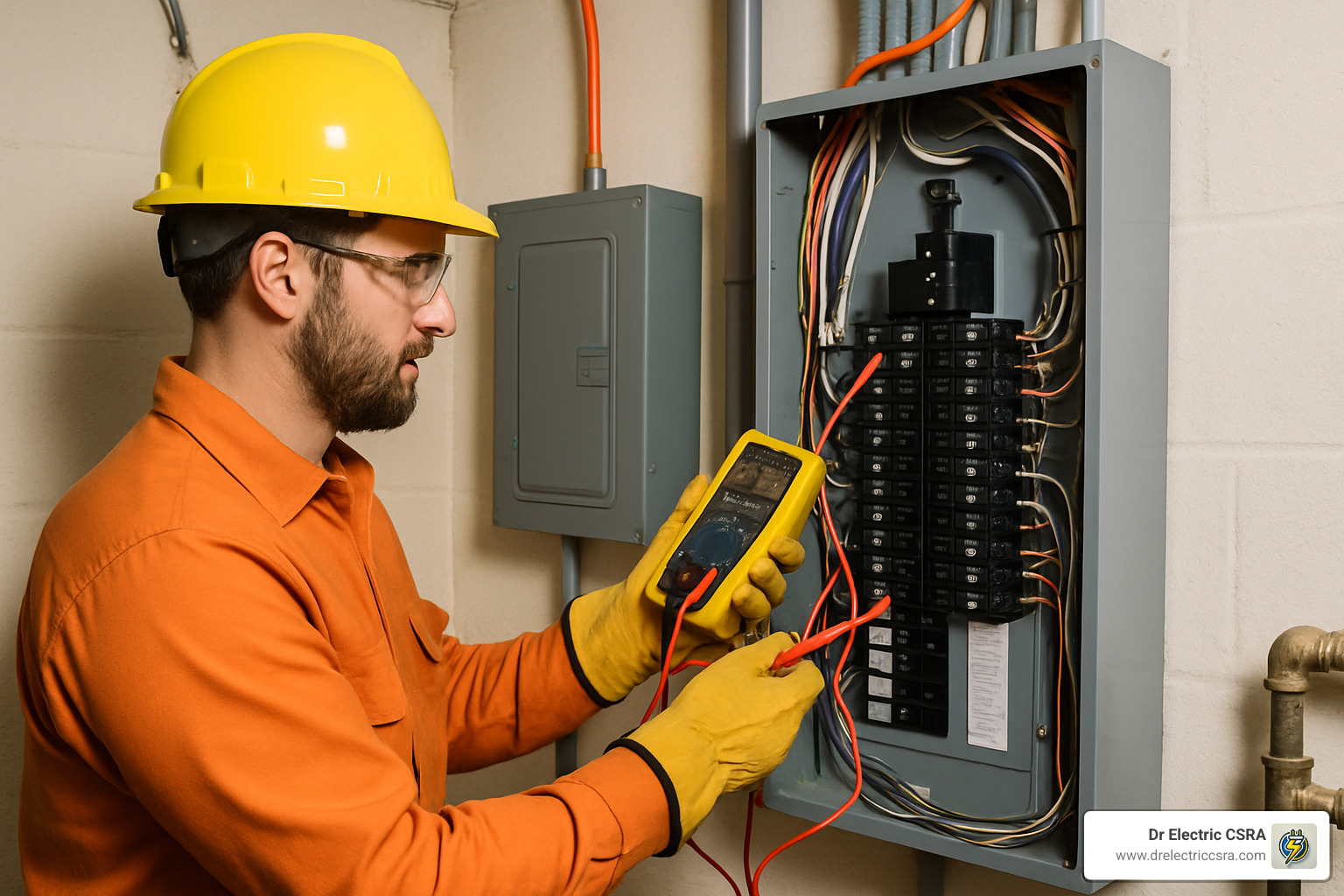
I’ve installed hundreds of generators around Augusta, and I can tell you that these seven factors make all the difference in your whole house generator installed price:
Generator size is probably the biggest factor. If you’ve got a sprawling home with multiple air conditioners and a well pump, you’ll need more kilowatts than someone with a cozy bungalow. More power means more dollars.
Fuel type matters too. Most Augusta homes go with natural gas because it’s convenient and cost-effective. But if you’re out in the country without gas lines, propane might be your go-to (though it’ll cost more to run).
Where you put your generator can save or cost you money. If it’s right next to your gas meter and electrical panel? That’s ideal. If we need to trench across your yard to connect everything? That labor adds up.
Electrical panel condition is something many homeowners overlook. I’ve seen plenty of older homes where we need to upgrade the main panel before we can safely add a generator. That’s an extra cost, but also an overall home improvement.
Local permit requirements vary wildly between Columbia County, Richmond County, and other CSRA communities. Some areas have stricter code requirements that add to your bottom line.
When you buy can actually impact price. After a major ice storm or hurricane, everyone wants a generator installed yesterday. Book during calmer weather, and you might find better pricing and faster installation.
Warranty length is worth considering. A 5-year warranty might cost more upfront than a 3-year option, but that extra protection often pays for itself down the road.
How Generator Size Impacts Budget
“How big a generator do I really need?” It’s the question I hear every day. Here’s my straightforward advice after sizing hundreds of systems:
If you have a smaller home (up to 1,500 square feet), a 13-16 kW unit will typically handle your essentials—lights, refrigerator, HVAC, and basic electronics. This is your most economical option, starting around $6,000 installed.
For mid-sized homes between 1,500-3,000 square feet, look at 17-20 kW generators. These can power most or all of your home’s needs simultaneously. Expect to invest $7,000-$9,000 for a complete installation.
Larger homes over 3,000 square feet or homes with multiple AC units, well pumps, or special needs typically require 22-25+ kW generators. These larger systems generally start around $9,000 installed and can go up from there.
Here’s a money-saving tip from someone who’s been doing this for years: Consider a smart load management system. These clever devices can let you use a smaller generator by automatically prioritizing your most important circuits. I’ve saved customers thousands by installing these systems instead of oversized generators.
Fuel Choices and Operating Costs
Your fuel choice affects both installation costs and what you’ll pay during outages. Here’s the real-world breakdown:
Natural gas is my recommendation for most Augusta homeowners. It’s connected directly to your utility line, so there’s no refilling tanks during a storm. It’s also typically the cheapest to operate at around $90 per day for a 21 kW generator.
Propane works well for rural properties without natural gas service. The installation is a bit more complex since you’ll need a properly sized tank. Daily operating costs run higher—often $120-170 per day—plus you’ll need to monitor fuel levels.
Diesel generators are workhorses but rarely used for typical homes. They’re more expensive upfront but last longer. They’re also the most expensive to run, often exceeding $170 daily during an outage.
Solar with battery backup is gaining popularity, but it’s still limited for whole-home coverage. However, it can be a great supplement to reduce generator runtime during extended outages.
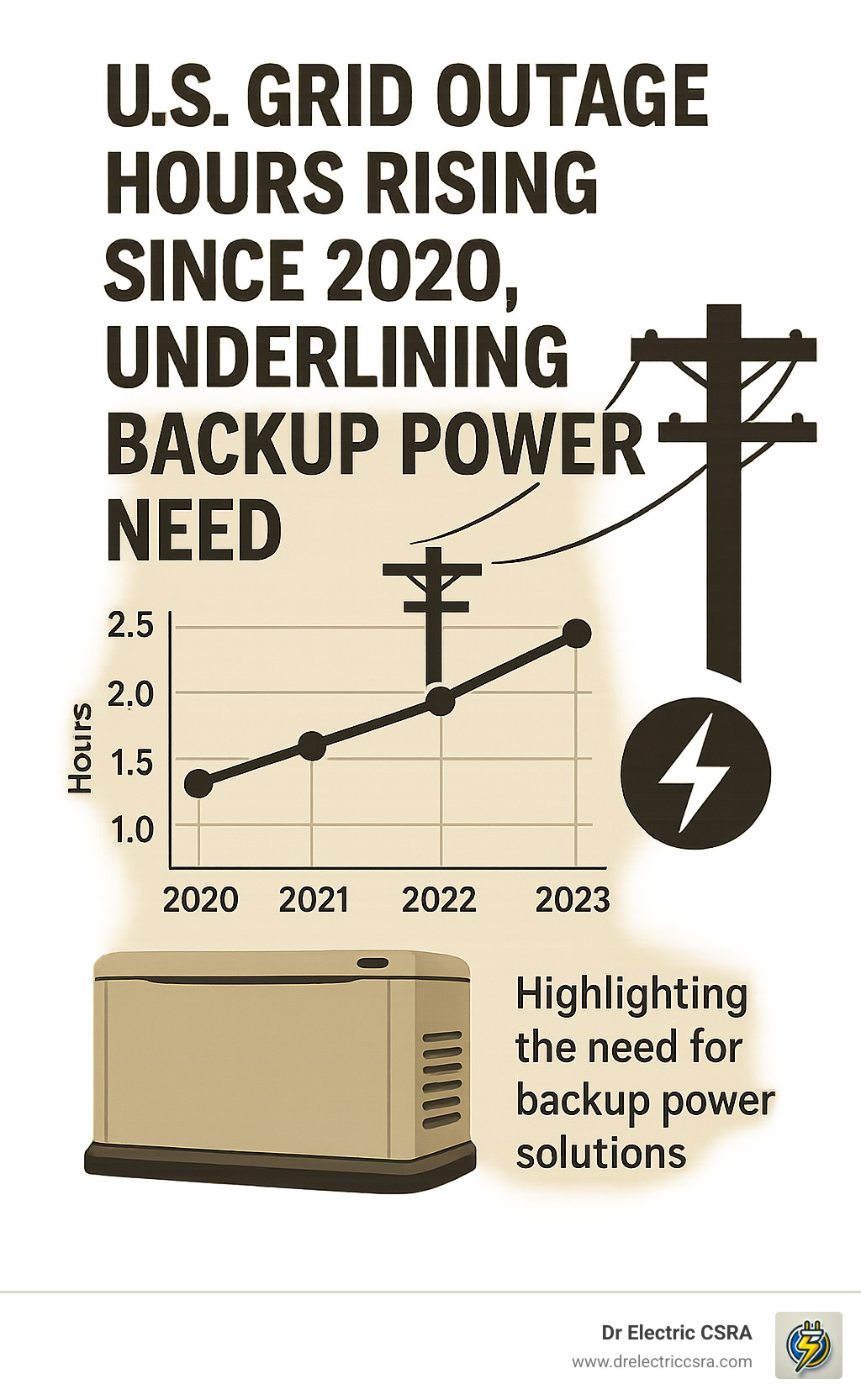
The sobering reality? Power outages are increasing nationwide, as this data clearly shows. Your generator might run more often than you think.
Hidden Extras Homeowners Forget
After installing hundreds of generators, I’ve noticed customers are often surprised by these necessary extras:
Concrete pad requirements vary by manufacturer and local code. While a simple installation might only need a $150 gravel bed, most quality installations require a poured concrete pad that can cost $400-$1,000 depending on size and site prep needed.
Cold weather kits are essential in our area. Augusta might be in the South, but we get enough cold snaps to warrant a battery heater and oil pan heater for reliable winter starts. These typically add $200-$400.
Remote monitoring gives you peace of mind through your smartphone. You’ll know if your generator is running, needs maintenance, or has any issues—even when you’re away from home. This $200-$400 addition is especially popular with our customers who travel or have vacation properties.
Annual maintenance is non-negotiable if you want reliability. Just like your car, generators need regular oil changes, filter replacements, and inspections. Most manufacturers actually require professional maintenance to keep your warranty valid. Budget $200-$650 annually, depending on generator size and usage.
For detailed pricing specific to your home, check out our comprehensive guide to Whole House Generators Prices Installed. Or better yet, give us a call for a personalized consultation and quote.
The Installation Process From Quote to Switch-On
Ever wonder what actually happens between your first call to us and that magical moment when your lights stay on during a blackout? Let me walk you through the journey of getting your generator up and running:
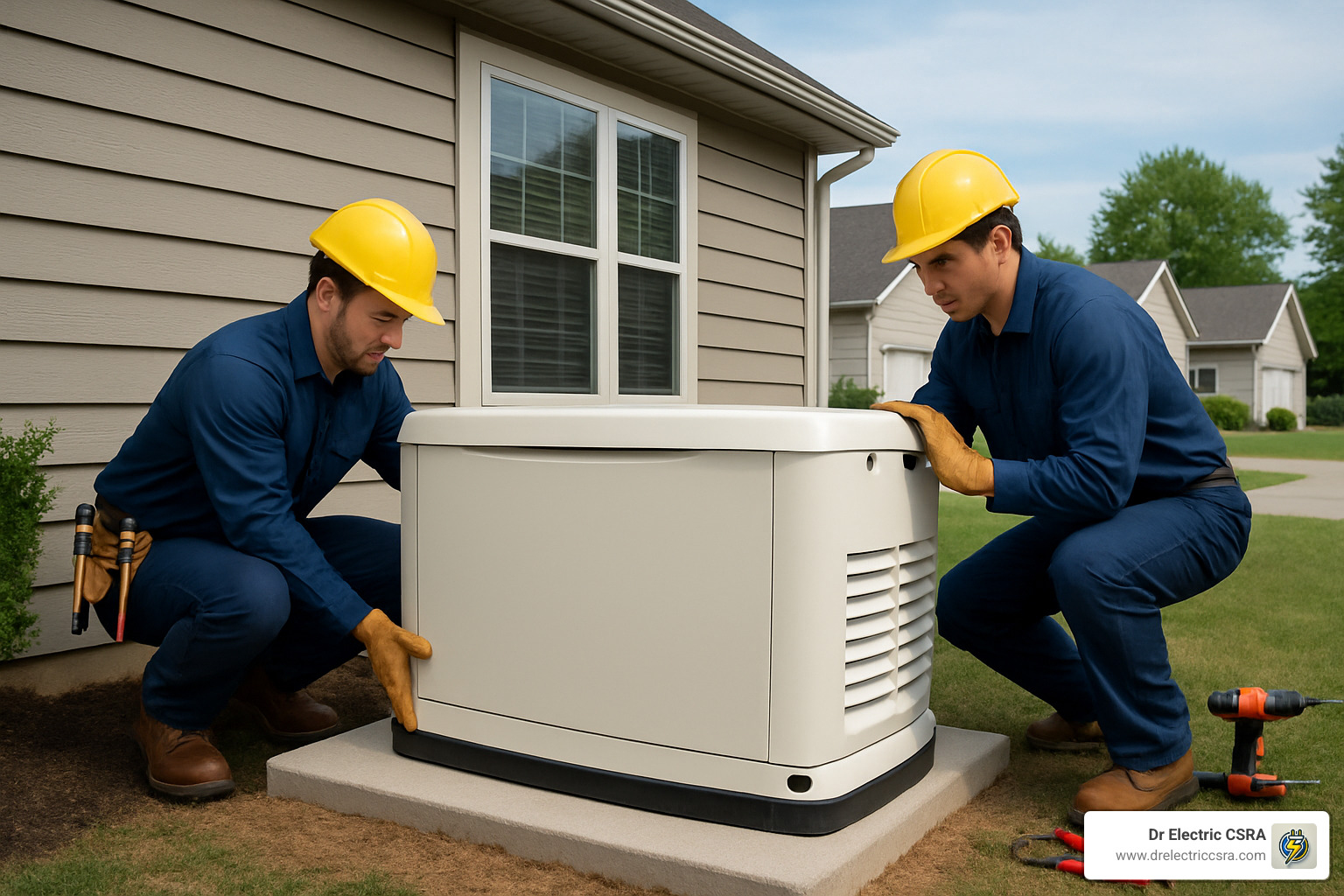
Step-By-Step Timeline
The road to backup power peace of mind is surprisingly straightforward when you work with professionals. At Dr Electric CSRA, we’ve streamlined the process into seven key steps.
It all begins with a site survey and sizing consultation. We’ll visit your home, take a look at your electrical panel, evaluate your power needs, and discuss the ideal placement for your generator. This is when we answer your questions and get a feel for what’s most important to you.
Next comes your detailed estimate. We believe in transparency, so you’ll receive a clear quote outlining all equipment costs, labor, permits, and realistic timelines. No surprises—that’s our promise.
The permit approval phase follows. This is where we handle all that pesky paperwork with city and county officials to ensure your installation meets Augusta and CSRA building codes. You don’t need to worry about navigating bureaucracy—that’s our job!
Before your generator arrives, we’ll complete the pad preparation. Whether pouring a concrete foundation or laying a gravel base, we ensure your generator has a stable, code-compliant home that will last for decades.
Install day is when the magic happens! Our in-house team (never subcontractors) delivers and sets your generator, runs all necessary wiring and gas lines, and installs your automatic transfer switch. This is typically the most exciting day for homeowners—you can actually see your investment taking shape.
After installation comes the utility inspection, where local inspectors verify everything meets safety codes. We maintain excellent relationships with local inspectors because we do things right the first time.
Finally, we perform commissioning and training. We’ll test your system, simulate a power outage to ensure everything works perfectly, and show you how to monitor and maintain your new backup power system. We won’t leave until you’re completely comfortable with your generator.
How Long Does Installation Take?
“How soon can I have backup power?” is probably on your mind. The onsite work typically takes just 1-2 days for most residential installations, assuming cooperative weather. Our experienced teams work efficiently without cutting corners.
The total timeline from your initial consultation to final inspection usually spans 2-4 weeks. Most of this time involves waiting for permits, equipment delivery, and scheduling inspections—not actual work at your home.
Be aware that supply chain factors can sometimes impact timelines. Certain generator models or specific parts may have longer lead times, especially during peak demand seasons after major storms. Just ask us about current availability for the models you’re considering, and we’ll give you honest answers.
Throughout the entire process, our team keeps you informed with regular updates, so you’re never left wondering what’s happening with your investment. That’s the Dr Electric CSRA difference—we treat your home like it’s our own.
Owning Costs: Fuel, Maintenance, Lifespan and Value Add
Once your generator is up and running, it’s smart to understand the long-term relationship you’re entering into with your backup power system. Like any significant home investment, there’s more to the story than just the upfront whole house generator installed price.
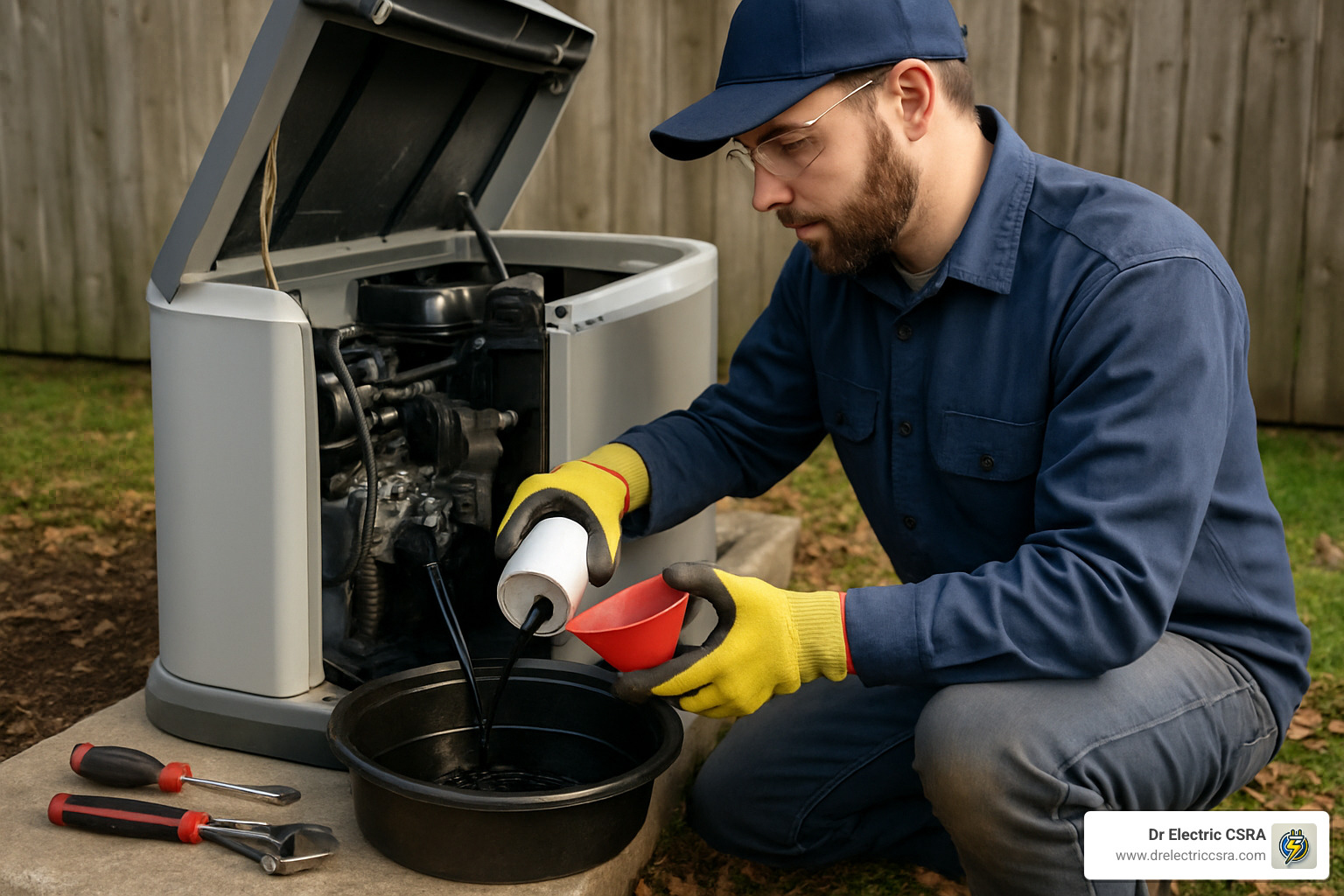
When the power goes out and your generator kicks on, you’ll be spending between $30 and $170 per day on fuel, depending on your generator size and fuel type. Natural gas typically runs on the lower end of this range, while propane and diesel can push costs higher. But considering what you’re protecting—refrigerated food, climate control, and basic comfort—most homeowners find this a reasonable price for normalcy during outages.
Your generator is essentially a car engine that sits outside waiting to serve you. And just like your car, it needs regular TLC to perform reliably when you need it most. Budget between $200 and $650 annually for professional maintenance services to keep your system in top shape. This preventative care isn’t just about peace of mind—it directly extends your generator’s lifespan to an impressive 15-30 years or 10,000-30,000 run hours.
Annual Maintenance & Repair Budget
Think of your generator maintenance schedule as simple but crucial. Your annual service typically includes oil and filter changes (at minimum once yearly or every 200 run hours), along with inspections of key components to catch small issues before they become expensive problems. Every couple of years, you’ll need spark plug and air filter replacements, and your technician should perform annual load tests to ensure your system can handle full capacity when needed.
“Our generator saved us during last winter’s ice storm,” shared one Augusta homeowner. “Maintenance was simple—just an annual oil change and filter. Worth every penny!”
Even with perfect maintenance, unexpected repairs occasionally happen. Most common are battery replacements, starter issues, or controller faults, typically running between $300 and $1,000. Establishing a service relationship with Dr. Electric CSRA means you’ll have priority access to technicians who already know your system inside and out when these situations arise.
Does a Whole House Generator Increase Home Value?
The financial case for a whole house generator goes beyond emergency preparedness. In today’s increasingly weather-volatile housing market, backup power systems have become a genuine selling point that buyers actively seek out and are willing to pay premium prices to secure.
National statistics confirm that homes with standby generators can see property value increases of up to 5%. Even more impressive, many homeowners report recouping more than 150% of their initial investment when selling their homes. That’s a remarkable ROI compared to many other home improvements.
Beyond the pure dollars and cents, there’s also the potential for insurance discounts. Several major insurance providers now offer reduced premiums for homes equipped with permanent backup power, recognizing that these systems reduce claims related to power outage damages like burst pipes, mold from sump pump failures, and food spoilage.
When you combine the daily peace of mind, the tangible protection of your property and possessions, and the financial upside of increased home value, the long-term cost of generator ownership becomes one of the smartest investments many homeowners make in their property’s future.
Frequently Asked Questions about Whole House Generator Installed Price
What is the cheapest way to achieve whole-house coverage?
If you’re hoping to keep your whole house generator installed price as low as possible, the smartest move is to focus on smart load management. This means you don’t have to power every single device at once. By prioritizing only your essential circuits—think fridge, HVAC, sump pump, and a few key outlets—you can usually get by with a smaller, more affordable generator. For example, in homes up to 1,500 square feet, a 13–16 kW unit can often cover your biggest needs without breaking the bank. It’s all about balancing comfort and cost. Don’t worry—you won’t have to give up your morning coffee or Wi-Fi!
How much does it cost to run a generator for 24 hours?
The daily cost to run a whole house generator depends on both the fuel type and the size of your unit. For a typical 20–22 kW model:
- Natural gas tends to be the most budget-friendly, usually running between $40 and $90 per day.
- Propane is more expensive, costing about $100 to $170 per day.
- Diesel units fall in a similar range, averaging $90 to $175 per day.
These numbers can shift with fuel prices, how efficient your generator is, and how much power your home is actually using. If you want a more precise estimate for your setup, we’re happy to walk through the details with you.
How can I cut installation costs without sacrificing safety?
Saving money is always nice, but safety should never take a back seat. The good news? There are a few practical ways to reduce your whole house generator installed price without cutting corners:
First, try to schedule your installation during the “off-season.” After big storms, demand (and prices) tend to rise, so you might snag a better deal if you book ahead of time.
If you’re handy, you can sometimes prepare the generator pad area yourself—just be sure to ask us what’s required to meet code. Even a little DIY prep work can help trim some labor costs.
It’s wise to gather multiple quotes before making a decision. But remember, if a price seems way too low, that’s a red flag. Always make sure your installer is licensed, insured, and has solid local reviews—your family’s safety is worth it.
And finally, don’t hesitate to ask about financing. At Dr Electric CSRA, we offer payment plans to make your project more affordable, so you don’t have to worry about paying all at once.
If you want the full list of services or more details on what’s included, check out our Electrical Services page. We’re here to help you get reliable backup power—without any surprises.
Conclusion
When the lights go out, nothing beats the peace of mind that comes from hearing your whole house generator kick in automatically. It’s not just about keeping the refrigerator running or the Wi-Fi on—it’s about protecting your family’s comfort and safety when they need it most.
Throughout this guide, we’ve walked through the real costs, considerations, and benefits of backup power systems. The whole house generator installed price might seem substantial at first glance, but when weighed against the increasing frequency of outages and the protection it provides, many homeowners find it’s one of the smartest investments they can make.
At Dr Electric CSRA, we’ve helped hundreds of Augusta-area families sleep easier during storms. Our approach is simple: we listen to your needs, design a system that fits your home and budget, and handle everything from permits to final testing with the care we’d show our own families.
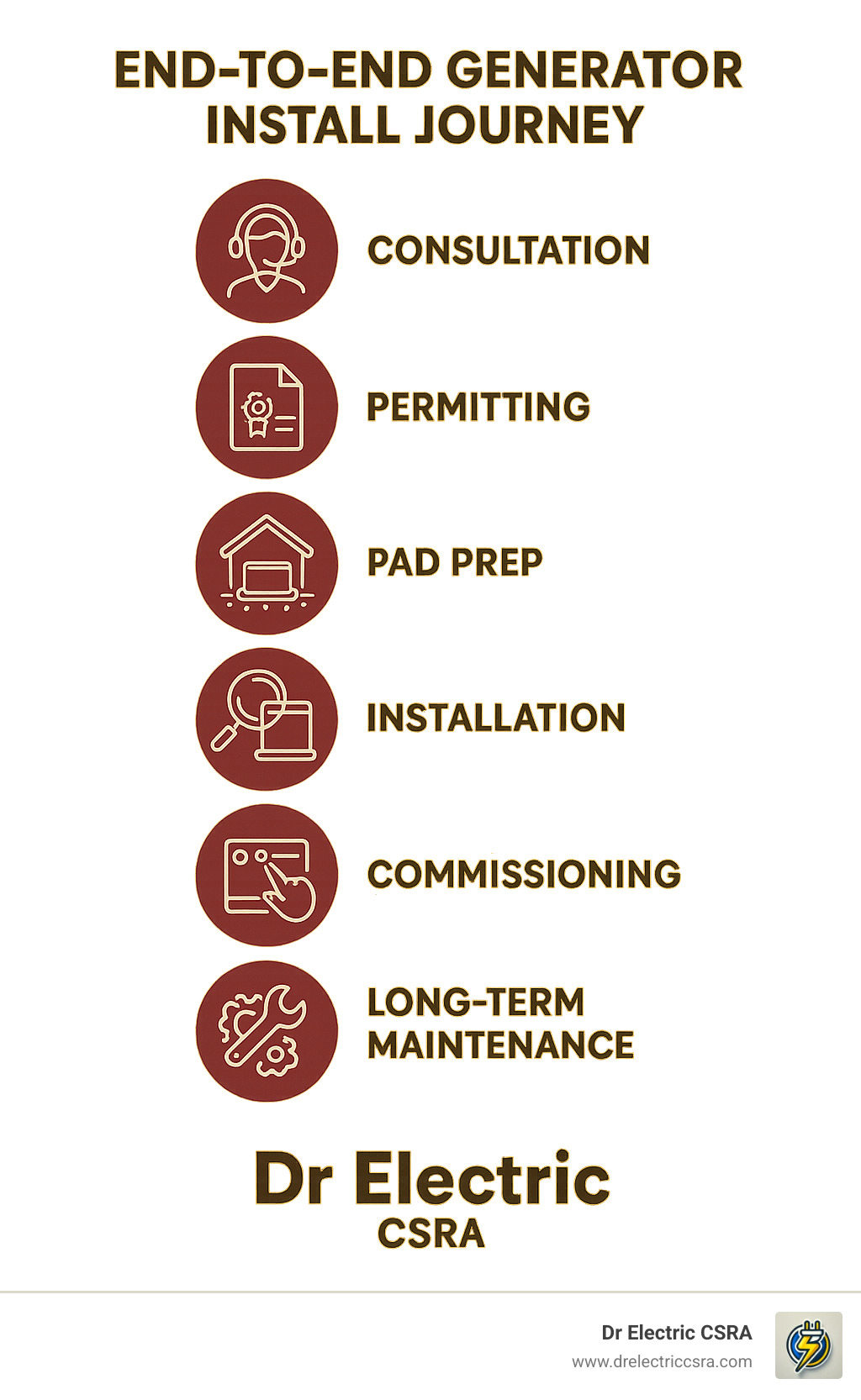
What sets us apart? We’re not just installers—we’re your neighbors. Our in-house team (never subcontractors) brings decades of electrical expertise to every job. We’re available 24/7 for emergencies because power outages don’t follow a 9-to-5 schedule, and neither do we.
Whether you’re protecting a modest ranch home or a sprawling estate, we’ll help you steer the options without the sales pressure. From selecting the right-sized unit to arranging annual maintenance that keeps your system ready year after year, we’ve got your back.
Ready to take the next step toward blackout-proof living? Learn more about our single-service installs or reach out today for a straightforward quote. We promise transparent pricing, professional installation, and the kind of service that’s earned us hundreds of five-star reviews across the CSRA region.
Remember: Your backup power is only as reliable as the team who installs it. Choose Dr Electric CSRA—the region’s trusted experts in safe, affordable whole house generator solutions.
Locations we serve: Augusta, Evans, Grovetown, Martinez, CSRA, and across Georgia.
24/7 Emergency Service | Licensed & Insured | Transparent Pricing | Satisfaction Guaranteed
More info about our services
Whole House Generators Prices Installed
Whole House Transfer Switch Installation Made Simple
Installing transfer switch for whole house generator
Latest research on outages
More info about single-service installs






0 Comments